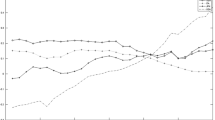Abstract
A VAR-GARCH-M model for aggregate employment and employment shares isdeveloped to explore the macroeconomic effects of sectoral shocks. Using U.S.,U.K. and German data, three main issues are investigated: the relevance ofshocks volatility; the amount of aggregate employment growth variationaccounted for by re-allocation shocks and the amount of aggregate innovation volatility explained by sectoral components. Bayesian methods are used for estimation model selection and innovation accounting – Bayes factors for model selection and MCMC for estimation. The results favor the VAR-GARCH-M model. A significant GARCH-M component indicates the presence of volatility clustering and the feedback of volatilities on aggregate employment and sectoral shares growth rates. The innovation analysis supports sectoral shocks as a triggering force for aggregate employment fluctuations. In all three countries, 45% to 55% ofaggregate employment variation is accounted for by sectoral innovations.
Similar content being viewed by others
References
Abraham, K. and Katz, L. (1986). Cyclical unemployment: Sectoral shifts or aggregate disturbances. Journal of Political Economy, 94, 507-522.
Aitkin, M. (1991). Posterior bayes factors, (with discussion). Journal of the Royal Statistical Society, B, 53, 111-142.
Bean, C. and Symons, J. (1989). Ten years of mrs. T. In O.J. Blanchard and S. Fisher (eds.), NBER Macroeconomic Annual 1989. Mit Press, Cambridge, MA.
Bera, A.K. and Higgins, M.L. (1993). ARCH models: Properties, estimation and testing. Journal of Economic Surveys, 7, 305-366.
Campbell, J.R. and Kuttner, K.N. (1996). Macroeconomic effects of employment reallocation. Carnegie-Rochester Conference Series on Public Policy, 44, 87-116.
Caporale, G.M. (1997). Sector shocks and business cycles: A disaggregated analysis of output fluctuations in the U.K. Applied Economics, 29, 1477-1482.
Chib, S. and Jeliazkov, I. (1999). Marginal Likelihood from the Metropolis-Hastings Output. Washington University MI, to appear in JASA
Davis, S.J. (1986). Allocative disturbances and temporal asymmetry in labor market fluctuations. Working Paper 86-38. Graduate School of Business, University of Chicago.
Engle, R. and Kroner, K.F. (1995). Multivariate simultaneous generalized ARCH. Econometric Theory, 11, 122-150.
Evans, G. (1988). Sectoral imbalance and unemployment in the United Kingdom. Discussion Paper No. 300. Centre for Labour Economics, London School of Economics.
Gallipoli G. and Pelloni, G. (1999). Sectoral shocks and labour reallocation. A survey, DP 2000.10. University of Sheffield.
Geiser, S. and Eddy, W.F. (1979). A predictive approach to model selection. Journal of the American Statistical Association, 74, 153-160.
Gelfand, A.E. and Dey, D.K. (1994). Bayesian model choice: Asymptotics and exact calculations. Journal of the Royal Statistical Society, B, 56, 501-514.
Gross, D.M. (1993). Equilibrium vacancy and unemployment: A flow approach to the Beveridge curve. Journal of Macroeconomics, 15, 301-327.
Jimeno, J.F. (1992). The relative importance of aggregate and sector-specific shocks at explaining aggregate and sectoral fluctuations. Economics Letters, 39, 381-385.
Kass, R.E. and Raftery A.E. (1995). Bayes factors. Journal of the American Statistical Association, 90, 773-795.
Koop, G., Perasan, H. and Potter, S. (1996). Impulse response analysis in non-linear multivariate models. Journal of Econometrics, 74, 119-148.
Koop, G. and Potter, S.M. (1999). Bays factors and nonlinearity: Evidence from economic time series. Journal of Econometrics, 88, 251-281.
Lilien, D.H. (1982a). Sectoral shifts and cyclical unemployment. Journal of Political Economy, 90, 777-793.
Lilien, D.M. (1982b). A sectoral model of the business cycle. MRG Working Paper No. 8231. University of Southern California.
Litterman, R.B. (1986). A statistical approach to economic forecasting. Journal of Business and Economic Statistics, 4, 1-24.
Loungani, P. (1991). Structural unemployment and public policy in interwar Britain. Journal of Monetary Economics, 28, 149-159.
Loungani, P., Oyer, H.E. and Rush, M. (1993). The sectoral shifts theory of unemployment in post World War II Britain. Division of International Finance, Federal Reserve Bank of Governors.
Mills, T.C., Pelloni, G. and Zervoyianni, A. (1996). Cyclical unemployment and sectoral shifts: Further tests of the Lilien hypothesis for the U.K. Economic Letters, 52, 294-304.
Mills, T.C., Pelloni, G. and Zervoyianni, A. (1997). Unemployment fluctuations in the U.K.: 1958–1992. Applied Economics Letters, 4, 253-255.
Ottersten, E.K. (1993). Sectoral shocks and structural unemployment: An empirical analysis. European Economic Review, 37, 115-133.
Ottersten, E.K. (1994). Sectoral employment shifts and unemployment. Labour, 8, 377-394.
Pelloni, G. (1992). Sectoral shifts and unemployment fluctuations in the U.K. Dynamics, 9/92, IDSE.
Pelloni, G. and Polasek, W. (1999). Intersectoral labour reallocation and employment volatility: A Bayesian analysis using a VAR-GARCH-M Model. Discussion Papers in Economics, 99/4, University of York.
Poirier, D.J. (1995). Intermediate Statistics and Econometrics. A Comparative Approach. The MIT Press, Cambridge, Massachussets.
Polasek, W. et al. (2000). The BASEL Package, Version 2.0. University of Basel.
Polasek, W. and Ren, L. (1998). Model selection for VAR-GARCH models using the BASEL package. Institute of Statistics and Econometrics, University of Basel.
Samson, L. (1990). Sectoral shifts and aggregate unemployment: Additional empirical evidence. Applied Economics, 22, 331-346.
Schettkat, R. (1992). The Labor Market Dynamics of Economic Restructuring: The United States and Germany in Transition. Praeger, New York.
Serrano, C.G. and Jimeno, J.F. (1999). Labour Reallocation, Labour Flows and Labour Market Institutions: Evidence from Spain. Centre for Economic Performance, London School of Economics.
Siebert, H. (ed.) (1997). Structural Change and Labor Market Flexibility: Experience in Selected OECD Economics. Institut für Weltwirtschaft an der Universität Kiel, Tubingen, Mohr.
Topel, R. and Weiss, L. (1988). Sectoral Uncertainty and Unemployment, in Employment, and Hours of Work. Boston, Little Brown.
Van Ors, J.C. and Van der Tak, C.M. (1992). Sectoral shifts, unemployment and vacancies: An empirical analysis of The Netherlands. Economics Letters, 39, 11-116.
Author information
Authors and Affiliations
Rights and permissions
About this article
Cite this article
Pelloni, G., Polasek, W. Macroeconomic Effects of Sectoral Shocks in Germany, The U.K. and, The U.S. A VAR-GARCH-M Approach. Computational Economics 21, 65–85 (2003). https://doi.org/10.1023/A:1022238914245
Issue Date:
DOI: https://doi.org/10.1023/A:1022238914245




